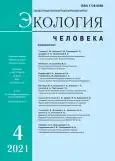ORAL HEALTH OF THE INDIGENOUS PEOPLE OF VAIGACH ISLAND, ARCTIC RUSSIA
- Authors: Vorobyeva N.A.1,2, Kunavina K.A.1,2, Golubovich A.V.1, Vorobyeva A.I.1
-
Affiliations:
- Northern State Medical University
- National Research Center of Hematology Russian Federation Northern branch
- Issue: Vol 28, No 4 (2021)
- Pages: 25-29
- Section: Articles
- URL: https://journals.rcsi.science/1728-0869/article/view/70890
- DOI: https://doi.org/10.33396/1728-0869-2021-4-25-29
- ID: 70890
Cite item
Full Text
Abstract
Keywords
Full Text
##article.viewOnOriginalSite##About the authors
N. A. Vorobyeva
Northern State Medical University; National Research Center of Hematology Russian Federation Northern branch
Email: nadejdav0@gmail.com
доктор медицинских наук, профессор, заведующая кафедрой; директор Архангельск
K. A. Kunavina
Northern State Medical University; National Research Center of Hematology Russian Federation Northern branchАрхангельск
A. V. Golubovich
Northern State Medical UniversityАрхангельск
A. I. Vorobyeva
Northern State Medical UniversityАрхангельск
References
- Воробьева Н. А., Воробьева А. И., Белова Н. И., Неманова С. Б. Концентрации филлохинона (витамина К1), полиморфизм генов биотрансформации, витамин К-оксидоредуктазы в популяции ненецкого этноса Арктического региона Российской Федерации // Тромбоз, гемостаз и реология. 2019. № 4. С. 46-54. https:// doi. org/10.25555/THR.2019.4.0899
- Горбатова М. А., Матвеева И. В., Дегтева Г. Н., Горбатова Л. Н., Гржибовский А. М. Распространенность и интенсивность кариеса у детей 10-14 лет Ненецкого автономного округа (Арктическая зона России) в зависимости от минерального состава питьевой воды и социально-демографических факторов // Экология человека. 2019. № 12. С. 4-13. https://doi.org/10.33396/1728-0869-2019-12-4-13
- Давыдов А. Н., Михайлова Г. В. Изменение климата и условия жизни в Арктике в восприятии ненцев острова Вайгач // Экология человека. 2013. № 2. С. 29-34
- Драчев С. Н., Юшманова Т. Н., Ипатов О. Н. Стоматологические аспекты здоровья взрослого населения, проживающего на территориях экологического риска // Экология человека. 2008. № 2. C. 14-16
- Кубрушко Т. В., Винокур А. В., Бароян М. А., Дударь Е. В. Стоматологическое здоровье у лиц трудоспособного возраста (35-44 года) // Международный журнал экспериментального образования. 2016. № 5 (3). С. 385-386
- Лебедев С. Н. Влияние социально-экономического уровня жизни на состояние стоматологического здоровья коренного малочисленного народа Севера ХМАО - Югры // Проблемы стоматологии. 2012. № 3. C. 33-35
- Лебедев С. Н. Частота и структура заболеваний пародонта и слизистой оболочки полости рта коренного населения Ханты-Мансийского автономного округа - Югры (на примере Нижневартовского района) // Уральский медицинский журнал. 2011. № 5 (83). C. 72-74
- Леус П. А. Стоматологическое здоровье населения: учеб. пособие. Минск: БГМУ, 2009. 256 с
- Максимовская Л. Н., Михаревич Н. Б., Соколова М. А. Интенсивность кариеса зубов у населения Ямало-Ненецкого автономного округа // Dental Forum. 2011. T. 40, № 4. С. 37-39
- Студеникин Р. В., Серикова О. В. Оценка качества жизни пациентов в стоматологии с помощью компьютерной программы // Здоровье и образование в XXI веке. 2017. № 19 (12). С. 234-239. https://doi.org/10.26787/nydha-226-7425-2017-19-12-234-239
- Юшманова Т. Н., Давыдова Н. Г. Cтоматологическое здоровье населения в возрасте 35-44 лет, проживающего на Европейском Cевере // Экология человека. 2003. № 1. С. 32-35
- Ashworth A. Understanding the factors influencing the aboriginal health care experience. Canadian Journal of Dental Hygiene. 2018, 52, pp. 208-212
- Farooqi F. A., Khabeer A., Moheet I. A., Khan S. Q., Farooq I., Arejaie A. S. Prevalence of dental caries in primary and permanent teeth and its relation with tooth brushing habits among schoolchildren in Eastern Saudi Arabia. Saudi Med J. 2015, 36 (6), pp. 737-742. https://doi.org/10.15537/ smj.2015.6.10888
- Gaur A., Sujan S. G., Katna V. The oral health status of institutionalized children that is. Juvenile home and orphanage home run by Gujarat state Government, in Vadodara city with that of normal school children. Indian Soc Pedod Prev Dent. 2014, 32 (3), pp. 231-237. https://doi.org/10.4103/0970-4388.135833
- Kyoon-Achan G., Schroth R. J., Sanguins J., Campbell R., Demare D., Sturym M., Edwards J., Bertone M., Dufour L., Hai Santiago K., Chartrand F., Dhaliwal T., Patterson B., Levesque J., Moffatt M. Scaling Up the Healthy Smile Happy Child Team. Early childhood oral health promotion for First Nations and Metis communities and caregivers in Manitoba. Health Promot Chronic Dis Prev Can. 2021, 41 (1), pp. 14-24. https://doi.org/10.24095/ hpcdp.41.1.02
- Mathur V. P., Dhillon J. K. Dental caries: A disease which needs attention. Indian J Pediatr. 2018, 85 (3), pp. 202-206. https://doi.org/10.1007/s12098-017-2381-6
- Parma С. Parodontopathien. Leipzig, Barth, 1960, 203 p.
- Smith L., Blinkhorn A., Moir R., Brown N., Blinkhorn F. An assessment of dental caries among young Aboriginal children in New South Wales. Australia: a cross-sectional study. BMC Public Health. 2015, 15 (1314), pp. 1-6. https:// doi.org/10.1186/s12889-015-2673-6
- Wei S. H., Lang K. P. Periodontal epidemiological indices for children and adolescents: II. Evaluation of oral hygiene; III. Clinical applications. Pediatric Dentistry. 1982, 4 (1), pp. 64-73.
- Williams S., Jamieson L., Macrae A. P., Gray C. A. Review of Indigenous oral health. Aust Indig Health Bull. 2011, 11 (2), pp. 1-18.
- World Health Organization. Oral health surveys: basic methods. 5th ed. Geneva, WHO, 2013, 128 p.
- Wulaerhan J., Abudureyimu A., Bao X. L., Zhao J. Risk determinants associated with early childhood caries in Uygur children: a preschool-based cross-sectional study. BMC Oral Health. 2014, 14, pp.136. https://doi.org/10.1186/1472-6831-14-136
- Youssefi M. A., Afroughi S. Prevalence and associated factors of dental caries in primary schoolchildren: an Iranian setting. International Journal of Dentistry. 2020, 2020, article ID: 8731486. https://doi. org/10.1 155/2020/8731486
Supplementary files







